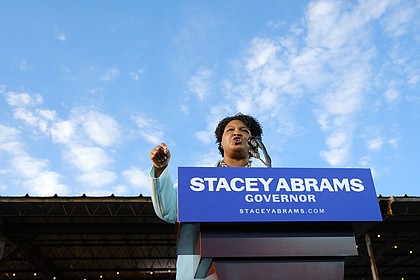People of Color MUST Get Out and Vote!
Jesse Jackson | 4/15/2022, 7:53 a.m.
Republicans are already gloating about the elections coming this fall. With Joe Biden lagging in the polls, Trump's Big Lie rousing the Republican base, inflation distracting from the remarkable jobs recovery, Democrats look to be in trouble. Much can change in the months left before the election -- and one central question is whether increased registration and voting among African Americans, Latinos and Asian Americans will begin to turn more districts and more states blue, particularly those in the South.
Here Georgia provides the model. In Georgia, a remarkable 95 percent of eligible voting age citizens are registered to vote. This is primarily the result of the state deciding to automatically register citizens when they obtain their driver's license. (There are, sadly, still more than 250,000 citizens, disproportionately people of color, who are barred from voting because they are incarcerated or on parole or felony probation.)
In Georgia, over two-thirds of voting age citizens cast a ballot in the presidential election of 2020. Voter participation was up across lines of race and education. Over 60 percent of eligible people of color voted. That turnout was due in no small part to the year-round organizing that came out of the Stacey Abrams Georgia Project during and after her run for governor in 2018. The project mobilized efforts to reach voters in their homes, educate them about how to vote and what is at stake, and helped turn their vote out for the election.
Can that energy and program be replicated in other states where Black, Latino and Asian American voters can make a difference? Consider in Arkansas, less that 43 percent of eligible people of color cast ballots in 2020 (that was down from 52.9 percent in 2016). That compared to over 51 percent of non-college white voters casting ballots and nearly 72 percent of college educated white voters. Arkansas has the lowest turnout of any state in the union, and not by accident. As Janine Parry, a political science professor at the University of Arkansas, Fayetteville, noted: "Arkansas for 200 years has designed a system to produce low voter turnout and that system has worked exactly as designed." Similar disparities were seen in South Carolina, where 52 percent of eligible people of color cast ballots in 2020 -- down from 63 percent in 2016, and elsewhere across the South.
The Democratic Congressional Campaign Committee (DCCC) which traditionally has focused its money and energy on so-called "swing voters" while slighting its base voters, now says it has gotten the message. It claims it will run a multi-million-dollar effort to replicate the Georgia efforts of on-the-ground organizing, hiring local community organizers, launching targeted ad campaigns, as well as voter protection and education programs, and efforts to counter disinformation efforts that marked the last election.
Engaging those who are not registered or do not vote is not easy. They tend to be working people who are struggling to make ends meet and have little time or energy for politics. They also tend to be people who are skeptical about whether an election can make any different in their lives.
If successful, however, the effort can make a difference -- in both congressional and statewide elections, particularly in states in the South where participation has been low.
Republicans understand this. When Barack Obama's candidacies raised Black turnout significantly, Republicans at the state level, aided by Supreme Court decisions that weakened the Voting Rights Law, started passing laws to make registration and voting more difficult, targeting Black voters particularly. After the record turnout of 2020, that effort was redoubled -- with Republican legislatures passing laws to cut back on early voting, limit mail ballots, reduce polling stations, add various voter ID impediments. They did this even though the white-Black turnout gap has grown since Obama's last run in 2012. In 2020, that gap was the highest in a presidential election since 1996.
Traditionally, the turnout of voters that form the core of the Democratic Party base -- African Americans, Latinos, Asian Americans, single women, the young -- drops sharply in non-presidential election years, like 2022. That -- plus Biden's weak approval numbers -- are largely why Republicans believe they will sweep to control the Congress this fall.
If people of color react to the insult of targeted efforts to discourage our voting, if Democrats actually invest in community organizers and year-round efforts to engage the disengaged, if the young rally against those who ignore the threats posed by climate change, and spiraling college and health care costs, then unexpected turnout can change the course.
When Lyndon Johnson signed the Voting Rights Act in 1965, he reportedly told aides that while this was the right thing to do, Democrats would lose the South for a generation. His prediction came true, for far more than a generation. The Republican Party anchored itself on white resentment in the South, perfecting race-bait politics to divide and distract working people, and voter suppression schemes to limit the voting power of people of color. Now however, the party of diversity is the majority party -- if its supporters are registered and come out to vote. If that happens, 2022 may just be the beginning of a new era of reform, rather than a turning away from it.
You can write to the Rev. Jesse Jackson in care of this newspaper or by email at jjackson@rainbowpush.org. Follow him on Twitter @RevJJackson.





